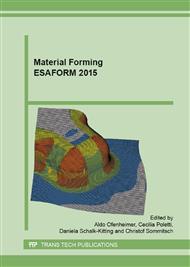p.38
p.47
p.53
p.59
p.65
p.71
p.77
p.83
p.89
Study of Localized Thinning of Copper Tube Hydroforming in Square Section Die: Effect of Friction Conditions
Abstract:
The friction conditions are responsible of the thickness distribution in a part realized by tube hydroforming. Then it is essential to have a good evaluation of the friction coefficient for running predictive finite element simulations. The tube expansion in a square die is one of tests proposed for the friction evaluation. In the literature, several analytical models have been developed for this specific test. The present paper concentrates on one of this model and results obtained from the analytical analysis, FE simulations and experiments are compared. The repartition of the thickness over the shaped tube and its evolution during the process are studied. The tendencies are in agreement but some complementary evaluations are proposed for using the proposed approach for the evaluation of the friction coefficient with the analytical model.
Info:
Periodical:
Pages:
65-70
Citation:
Online since:
July 2015
Keywords:
Price:
Сopyright:
© 2015 Trans Tech Publications Ltd. All Rights Reserved
Share:
Citation:


